American Sabbatical 95: 4/16/97
Faulkner Country
4/16.. Faulkner Country.
The slamming of dumpsters and the grinding of garbage trucks in the alley brought us back
to reality in Memphis. Downstairs the air outside the hotel was
redolent with ripe compost in warm sunshine. We couldn’t get out
of town fast enough.
The Owlers had one more site to wink at in the Kingdom, though.
Chucalissa. Yet another Mississippian Culture site, on the southern
fringe of metro Memphis. Would it be in as hard a shape as the
mounds under the Old Bridge? Engulfed by blight like Graceland?
Renewed beyond recognition like Beale Street? With trepidation
we followed gigantic wheelers jake braking down a steep grade
through a lowrent burb, and into deep woods. Jungled woods. Solid
undergrowth, tanglevines, the lushness down by a sump.
Brown signs angled us out of the industrial chute, and into a
backwater museum lot. We faced a low, undistinguished cement building
nestled into a hillside. Another well lived-in vehicle swung into
the lot behind us, and the driver got out with keys in his hand,
apologizing for being late to open shop. We were gracious, and
said we were going to concoct a breakfast before doing the tour.
“ Isn’t it nice to be intimidating?” Peggy whispered. I AM getting
rather shaggy, but intimidating? Another museum laborer drove
up and his wolf-dog began howling at me. But his tail was wagging.
A splendidly beautiful beast, with the palest of gray eyes. I
started feeling like an Alpha dog here in a Mississippian woods
with a hot sun sidling down.
(Memo #90)
April 15 Chucalissa
Who? Mississippian people, the “mound-builders”
What? reconstructed Mississippian village and small museum
When? village occupied between A.D.1000 - A.D. 1500
Where? in a park on the southern edge of Memphis on Choctaw Bluff
How? a good question, funding for this dandy museum is at risk
Topics: prehistoric Native Americans, mound builders
Questions: How do you make prehistoric people real? What makes
a good museum? What was a Mississippian village like? |
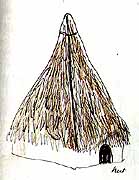
Hut
|
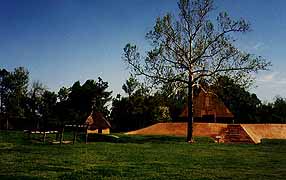
Chucalissa
|
We have visited a number of preColumbian sites in our travels:
Cahokia (memo #13), Ocmulgee (#82), Etowah (#83). Each has added
to our knowledge of the Mississippian culture, the “mound builders”.
We’ve gotten a sense of the natural world they lived in and the
extraordinary mountains (hardly “mounds”) they constructed of
earth, basket load by basket load. Chucalissa, a reconstructed
village in a park on the southern edge of Memphis, finally made
the culture and the PEOPLE come alive.
|
| Chucalissa (a Choctaw word for “abandoned house”) is a magic spot
. The archeologists have reconstructed a Mississippian village
with a chief’s house on a small mound, houses around a central
plaza, a raised granary. Life sized mannequins dressed in the
feathers and clothing and jewelry of the Mississippian people
are posed in tableaux in the thatched huts with appropriate furnishings
and objects and tools and weapons. There are no modern buildings
in sight, just woods and sky and a creek below the bluff. |
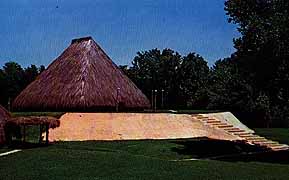
Chief's House
(Postcard)
|
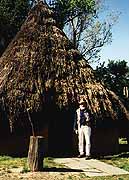
Entrance
|
Even more extraordinary is the WAY you enter the village. First
you tour a small museum. Each exhibit (of tools or pottery) shows
people making and using the items. This hardly seems radical but
is a real change from the earlier museums (and approach to Archaeology)
in which the objects in and of themselves became more important
than the behavior that shaped them or the people that used them.
It makes a real difference to see a hand around an atlatl or the
whole animals next to the burned bone fragments that were found
on the site. So the museum itself is great, then you go through
a passageway with Chucalissa designs in bright colors on the walls
and you enter.. a trench. You literally walk through an archaeological
excavation seeing the different colors of earth in the difference
layers of habitation (orangey and yellow and tan) rising straight
up on either side of you.. There are excellent labels explaining
what you are seeing (what a “burned” house structure” looks like
as a black layer) and how archaeologists interpret remains. Then
you are at a low doorway. You duck down as you climb up and you
are in the sunlit plaza, having entered through a hut doorway
as though from a native house!
|
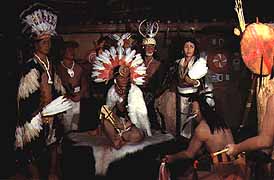
Chief
(Postcard)
|
“The first house outside the Entrance Trench has been furnished
as it might have been while in use. The mother works on her weaving
while the grandmother watches the baby and prepares a meal of
freshwater mussels. The Father attaches a stone point to an arrow
, and the younger children play nearby. A cane fish trap is stored
on the overhead rack. Bear skins serve as blankets on the bench
beds along the walls. The furs hanging overhead would be used
in trade with other towns and by local dignitaries.” (from A Visitors’
Guide to Chucalissa). |
| The Chucalissa huts are extraordinary. The huts (perhaps fifteen
feet square) have steep thatched roofs with eaves that come within
four feet of the ground. The walls are mud over matting, the whole
structure is framed with large posts. There are wooden “platform”s
or “benches” along the sides, a fire in the middle of the floor,
a variety of artifacts hung from beams or on the ground. They
have also constructed a low mound with a large chief’s house on
it. The front side of the mound giving on the plaza is plastered
with “mud” and has steps leading up. Inside a tableaux shows figures
paying tribute to the chief (a woman) who sits cross legged on
a wooden platform. |
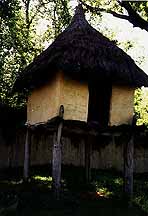
Granary
|
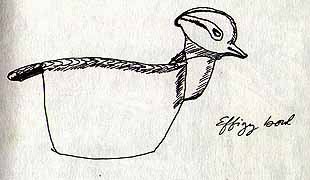
Effigy Bowl
|
We found, yet again, how neat it is to be alone in an historical
site. We arrived before the museum opened and were alone for an
hour tour of the reconstructed village. Unfortunately, the two
Choctaw interpretive guides who are on staff were not there the
day we visited. Also unfortunately this superb recreation is not
mobbed everyday! We saw far more visitors at Etowah. |
| Ideally we would create a tour that takes people to a number of
Mississippian sites - Ocmulgee and Etowah in Georgia, and Chucalissa
in Tennessee (all of these small towns), and finally Cahokia in
Illinois (the incredible city of perhaps 20,000). We could add
the Spiro Mounds (Oklahoma), Pinson Mounds in Tennessee, Moundville
in Alabama. I would call the tour “North American Towns and Cities
BEFORE Columbus”! |
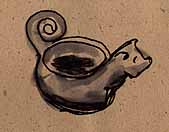
and another
|
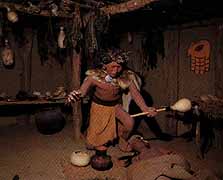
Shaman
(Postcard)
|
How is it that Americans know of the preColumbian Aztec and Inca
and Mayan cities and not those in Illinois and Alabama?? One cynical
answer is that we couldn’t admit that North American Indians had
“civilizations” and “cities” without admitting that our treatment
of them was straight conquest and genocide. We justified many
actions on the frontier by the notion that we were “civilizing”
and “Christianizing” the savages.
I taught on the Hopi reservation in the 1960’s and even then a
BIA teacher told me we were “raising the Indians to be right civilized
folks!” |
Chucalissa village makes the preColumbian Mississippi culture
vivid and appealing.
4/16.. Cont.
Entering Chucalissa through the below-grade dig was strong magic. Passing from incandescent
interior modern into stratified earthwalls of archeological time,
then scooching out a low doorway into an Indian village. POW.
The high-peaked chiefs’ lodge sitting atop the great mound, with
clay steps leading up. The exotic houses all around the 2 acre
square, with their steep-pitched thatched roofs. The sense of
being in a world apart was as gripping as great theater, or sculpture.
| We came away stilled once more. Even the insinuating haze of agro-industrial
chemicals couldn’t stifle the meditative mood. Driving out, a
pileated woodpecker swooped within a foot of my open window. A
big bird up close. And the face tattoos and bold colors of the
Indian costumes were alive in today’s woods. I'd spent twenty
minutes copying a copper image of a dancing bird-woman from a
thousand years ago. Here was another, plummeting, past. |
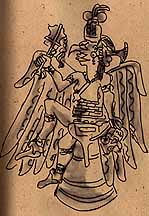
Bird Woman
|
Round a corner and it was Thunder Road, then Elvis Presley Boulevard.
Graceland is only about half a mile from Chucalissa, and the juxtaposition
was too much. Mounds for a ancient kingdom, and a pile for The
King. We plugged ELVIS LIVES back in the box as we rolled past
the American Dream memorial.
Into Mizsippi. Except for a brief hiatus of striving burbs, with
white brick and wrought iron detailing, the wasteland of South
Memphis merges into worn agriculpability with hardly a gasp. Beat
trailers and parts cars on fallow fields or between plowed acres,
with the wind picking up a yellow dust. Where the blues was born.
You sure have to look inward to find the music in these alluvial
bottoms. Tellum, Lucille.
We had considered seeking the balcony where Martin was shot in
Memphis, but decided the city was dark enough without the memory
of gunfire. Now we were in environs where his dream of judging
people by the content of their character seemed especially apt.
We’ve seen a lot of Black middle class in the South. Here was
some downhome poverty.. a classic stereotype of “shiftlessness”,
if you were to use the old labels. But we’ve climbed a long hill
from that Memphis. These scenes remind us that the big issue in
Capitalist America isn’t race. It’s class.
The wornout lands come and go in Northern Mississippi, though.
One minute soul-dead vistas, the next undulating woods and pastures,
and back again. The leaves are almost all out here, and the patterns
of vegetation are clumpier, foliage mushrooming like cumulonimbus
before a squall. Scattered crossroads with low-eaved gas stations
and convenience stores. Then we hooked onto a sideroad at Sardis
and wiggled into the tall timber near the lake. Sardis Lake, made
of the dammed headwaters of the Tallahatchie, 25 miles long, east-west.
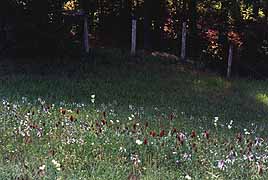
Mississippi Flowers
|
Everywhere we’ve been in the South different wildflowers have
graced the shoulders of the road. Here foot-tall crimson clover
paints the roadsides in Harvard red, for miles. We stop to use
the facilities down a yellow stone road that winds through windy
pine woods, then skirt the blustered lake, and make tracks for
Oxford town, around the bend.
|
Oxford town. Maybe the most charming county seat in the South.
Another of those high-flung cupola capped courthouses with a four-square
Greek facade, but surrounded this time with live businesses..
bookstores, bakeries, cafes.. in restored brick storefronts, behind
balconied overhangs decked in ornamental iron or classical pillars.
It’s a college town, of course. Ole Miss. Oxford town.
Our roadfood guide scores again. The cornbread and bean special
in the recommended cafe is just fine, but the blackberry and peach
cobblers are to sigh for. We perambulated round and about the
square until our joy settled. Then went to check out Ole Miss,
and find Faulkner’s house.
The former looks just like a big state U. with the usual excess
of cardiovascular exercising and self-consciousness. Massive formal
architecture, intercut with venerable giants in the forestry department.
Hardwoods in full habit cooling the air and shading the sunsplashed
lawns. The echoes of Dylan’s music, or the jackboots that gave
him the beat, have faded into silence in this polychrome enclave.
At least we couldn’t hear them.
| We could hardly find Faulkner’s house. There are no brown signs
and the maps are (intentionally?) vague. But Southern hospitality
won’t leave you lost for long, and we parked the Owl in Bill’s
home grove. The Saddest Southerner lived up a winding yellow gravel
drive between lines of 150 year-old-cedars. Between the gloomy
boles, beds of irises edge the path, now raising their purple
flags to salute the wind. Drawing another classic Southern house
didn’t do it for me, so I sat among the irises and tried to render
Faulkner’s road in line and color, while Peggy did the tour. |
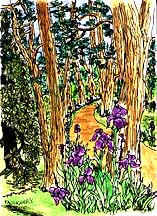
Faulkner's Drive
|
(Memo #91)
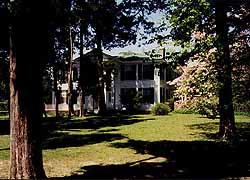
Rowan Oak
|
Apr 16 Faulkner’s Rowan Oak
Who? William Faulkner, Nobel Peace Prize author
What? his longterm home
When? house he bought in 1930 and owned until death in 1962
Where? Oxford, Mississippi
How? renovated little by little
Topics: American literature, Southern literature
Questions: What were Faulkner’s inner and outer worlds like? How
does a home-museum work best? |
Faulkner, it seems, is more studied abroad than any other English-language
author except Shakespeare. In college I took a phenomenal comparative
literature course called “Dostoevsky, Camus, and Faulkner”. Of
the three, Faulkner is the author who has stayed with me. I feel
the many layers of time that Faulkner caught so well, a phrase
calling up a moment ten years ago echoed in an older family history
incident, the weight in the present of a decision made by a great
grandparent, a word having many personal allusions past and present
(like Benjy’s “caddy”).
Faulkner’s Yoknapatawpa is so real and vivid that it colored my
preconceptions of the South. Doom, family destiny played out over
decades, time linking tragedies through centuries, the weight
of the past. At some level I expected to find a “dark” region,
brooding presences, yet the South has been bright and beautiful,
the people uniformly friendly. Occasionally we see the wreck of
a grand house in the brush that calls up the Sutpen house. As
we drove into Mississippi I wondered if the Snopeses and Sutpens
are real, if Clytemnestra and Judith and Henry and Quentin were
based on real people in Oxford Mississippi. Did Faulkner convey
a place in true geography?
Rowan Oak (the Faulkner home in Oxford) is down a side road a
mile from the classic courthoused town square. The few markers
are unobtrusive. As you walk the path through the 150 year old
cedars to the large white house, you sense a paradox. Faulkner
lived in a lovely, large house full of sunlight and comfortable
nooks and crannies. It is roomy and has the requisite white columns
and fireplaces, but it feels comfortable and loved and there are
lovely views from all the windows. The couches look comfortable,
the armchairs and rockers good for reading. There is a beautiful
garden, lawns stretching to woods, and paddocks. Irises line the
drive. Faulkner took time and care renovating and enlarging the
house and lived here for thirty years with his wife Estelle, two
stepchildren, and a daughter Jill. Most of his books were written
here. He was a man living in a “sunny” place who had a dark interior
landscape. Incredible cognitive dissonance. And this is part of
what Faulkner captured in his writing: the ability of people to
live in hellish personal landscapes while their bodies inhabit
even sunny and beautiful worlds. Rosa “living” the dark history
of the Sutpens.
| The young man who opened the house is an Ole Miss English professor
who answered my questions. Yes, Faulkner had a dark inner world.
Faulkner was a binge drinker (often after he finished a book)
who would regularly go to a sanitarium to dry out. His publisher
once convinced him to see a New York psychiatrist who reported
that Faulkner had the greatest capacity for sorrow of any man
he had met. |
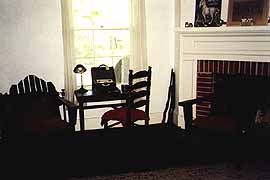
Faulkner's Weapons
|
The house was built by a colorful Colonel Shegog in the late 1840’s
who owned many farms in Tennessee and used this one mainly to
count his money. This old colonel had elements of Sutpen. Other
local and house stories gave Faulkner bits of plots. He told his
children of Judith Shegog who died climbing down from the front
balcony to run off with a union soldier (Judith Sutpen? Quentin?).
Faulkner’s own family, the professor says, is played out in the
recurrent theme of a legendary greatgrandfather with a father
who is a failure (Faulkner’s own ggf owned a railroad which was
sold before the gf and father could run it).
When Faulkner bought the house it had been partly used as a stable
and had no plumbing or electricity. His wife fainted when she
first saw it. It took them many years to renovate. Faulkner would
regularly go to Hollywood (which he hated) for a script writing
job to earn the money.
After we went to Monroeville, Alabama, and never really found
the world of Harper Lee, I convinced myself that it’s the product
(the books) that matter, not the author’s home. In Faulkner’s
case, the home adds a great deal. First as a paradox. A key seems
to be the WAY a house is preserved, how consciously and formally
scripted the tourist experience is, how much has been changed.
A young man opened up Rowan Oak and then said, “ Look around,
it’s a self tour.” So we did. The rooms have been left as they
were in 1962. Bill’s muddy boots are by his bed, books are piled
by and on tables. There are family pictures and oil portraits
on the wall (one of Faulkner in hunt clothes). Faulkner loved
riding and fox hunting and, in his last years, spent more and
more time with his daughter’s family in Charlottesville, Virginia,
where he was lionized. Apparently, Oxfordians never really fawned
over Bill, who had been known as “Count No Account” when he was
at the college. The town knew Faulkner’s family too well. There
are no tape recorded guides or plastic rug coverings to direct
our steps. I could wander, go back, take pictures, ask questions.
In his office, Faulkner had put the plot outline of A Fable on
the wall. It’s still there.
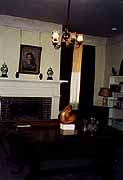
Interior View
|
The young professor said the university’s aim in preserving the
house was to spark discussion of Faulkner’s works and there is
a conference held each year. The focus is not on the possessions,
so the house does not have the self-consciousness of many house
museums where the guides lovingly directs your attention to the
grain of a particular china cabinet and the hidden drawer. The
details on rugs and china and silverware sometimes obscure the
people. Faulkner himself does not seem to have been very “invested”
in possessions (except for horses). Maybe he never lusted for
or attained “success”. Elvis did and the Graceland tour caught
that too. Again it’s a question of the personality being captured
in the house.
|
Perhaps Faulkner’s lovely home and family provided him with a
safe haven from which he could journey into the dark with a chance
of surviving.
4/16.. cont.
I was all for staying in Oxford, idling in the square, drawing a live town, finding a bed. But
Peggy was bubbling with enthusiasm. Energized. And had a case
of the hurryons. It was a bright warm afternoon, and we even contemplated
camping. Leaving Homer asleep in his knapsack. Besides, the prices
at advertised hostelries around Oxford were academically inflated,
like college tuitions.
Back into the rolling terrain of North Central Mississippi. The
navigator soliloquizing, the pilot trying to keep his eyes open.
Southeast of Oxford we were back in the timber factory, big rigs
woofing by, single trailers piled high with long pine poles, tandems
full of fatbutted hardwoods. “WELCOME TO BRUCE: Where money grows
in trees.” A lot of this country could be Maine in June. The log
trucks were lined up at the Weyerhauser entrance. Another colonial
empire. Clearcuts and cattle pastures. Rich rank woods and fallow
lands all bronze with old hay. Bright yellow mustard run amok.
We were slanting southeast to pick up the Natchez Trace again,
hoping it would be as glorious as it had been in Tennessee. And
keeping an eye out for Yoknapatawpa. But that must be an interior
landscape, or a world by night. Having spent seven years in Washington
County, the eastern end of Maine, and the poorest county in New
England, we have pretty good antennae for Snopses. Down in the
valley of the big river it’s dark enough for Faulkner, and he’d
have been at home in Jonesport, but in Calhoun and Webster Counties
there was too much sunshine today. Even in that transitional state
of near fatigue I didn’t get intuitions of despair along highway
9 to Eupora.
| Then we were back on the Trace. It IS a spectacular corridor through
time and nature. Turns out the whole road is a federal park, from
Nashville to Natchez (some 250 miles), with a right-of-way a football
field wide. Like the beauty strips in Maine, it may pass through
clearcuts and agri-mining (a ranger told me it does), but you’d
never know it. The only through traffic is the occasional highway
tortoise with grandpa at the wheel. Down here in Mizsippi the
foliage is denser with undergrowth and the full leaves are losing
their pastels. The ghostly dogwoods in the receding gloom are
gone, or have cast their blossoms, but the shoulders are filmed
with lavender-blue flowers (heal-all), uncanny in the low-angle
light. |
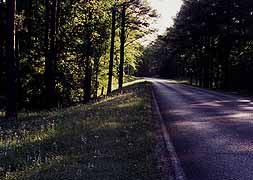
Trace Flowers
|
The Trace descends into drowned bottoms, and waterloving trees
engloom the road. Cypress, tupelo, the gums. We stop and follow
a nature trail in a loop up onto higher ground where the large
pines and hickory dominate, then back down to skirt the slough.
No serious bugs at this evening hour. A good omen for camping.
But the campground was full of Winebagos and snowbirds moving
north. Their jawing might have been convivial, but we weren’t
up for cheek-to-jowling in the crammed sites. Federal standards,
remember. So Peggy found a chain flop a few miles farther along
the Trace, in Kosciusko, and phoned in a res. After this journey
she could have a new career as a travel agent. She’s even talking
about the Mississippian Culture Tour. Mounds I Have Known. We
dossed down for the night in Kosciusko, without a z. We added
the zs.















